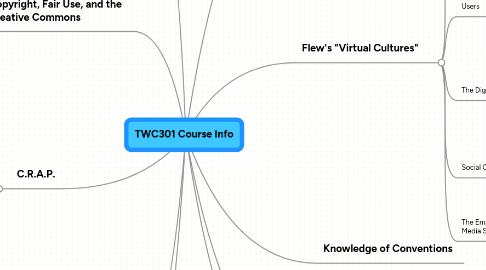
1. Critical Thinking, Reading, and Writing
2. To learn to communicate in a variety of ways
3. To learn to organize my thoughts in ways that will be understood through different technologies
4. C.R.A.P.
4.1. Contrast
4.1.1. Primary
4.1.2. Secondary
4.1.3. Create focus
4.2. Repitition
4.2.1. Unifies all parts of a design
4.2.2. Controls a readers' eye
4.2.3. Organizes
4.2.4. Creates Visual interest
4.3. Alignment
4.3.1. Draws the eye where you want it
4.3.2. Avoid centering
4.3.3. Visuals should help add meaning
4.3.4. Creates unity on a page
4.4. Proximity
4.4.1. White space is okay
4.4.2. Grouped items
5. Copyright, Fair Use, and the Creative Commons
5.1. Copyrights are to be treated with respect otherwise there could be extreme monetary consequences
5.2. The public domain is a place where information is free to acquire. Copyright has already expired on most of the items
5.3. Creative Commons is a site where people can modify their copyrights and allow certain uses, so that their ideas can be built upon and experiences.
5.4. Fair use is when the idea that is taken is not distorted or used for commercial purposes.
6. Processes
7. Rhetorical Knowledge
8. Knowledge of Conventions
9. To be able to view my work through others' eyes
10. Flew's "Virtual Cultures"
10.1. Virtual Communities & Online Identities
10.1.1. Community Memory--First community network system
10.1.2. Online Identities allow a person to take on an identity significantly different then their "real life" one
10.1.3. The internet has already changed dramatically over time
10.2. Participation in Virtual Cultures: The Social Psychology of Internet Users
10.2.1. A way of connecting and participating with people such as yourself (sharing ideas)
10.2.2. People who have the same agendas (who want the same things)
10.3. The Digital Divide
10.3.1. The internet is evolving on a geographic level
10.3.2. The issue of who can or cannot afford the internet
10.3.3. Male vs. Female users. Males were always ahead on this, but not the women take the lead
10.4. Social Capital and Social Software
10.4.1. "features of social life-networks, norms, and trust-that enable participants to act together more effectively to pursue shared interests...Social capital, in short, refers to social connections and the attendant norms and trust" (Putnam 1995:665)
10.5. The Empirical Turn in New Media Studies
10.5.1. The way that people interact
10.5.2. What is really real?
10.5.3. Geographic Location
